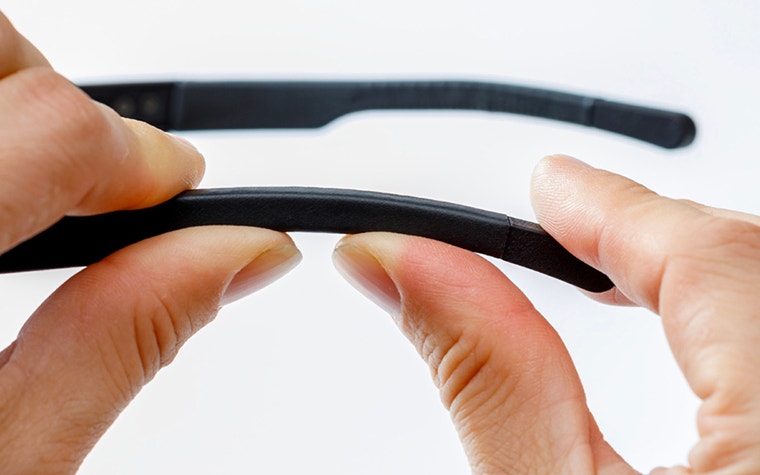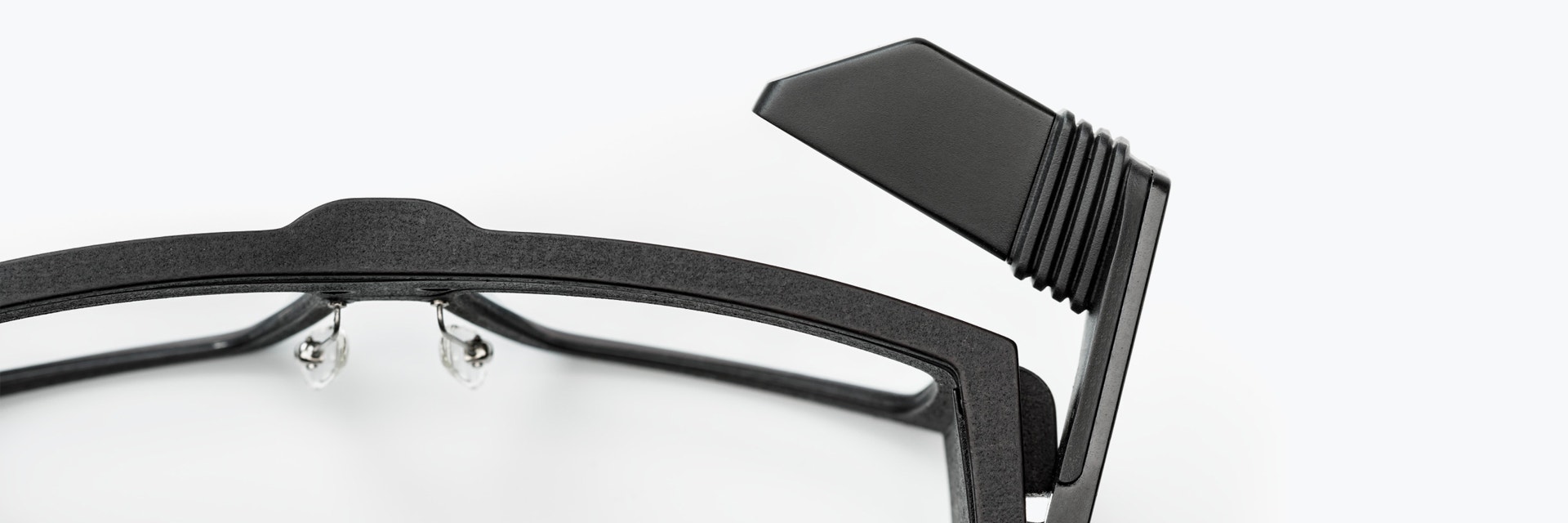CASE STUDY
Iristick Smart Glasses Get Smarter with 3D Printing

Iristick’s smart safety glasses are at the cutting edge of design and electronic engineering. Working with Materialise, Achilles Design was able to get Iristick into small-series manufacturing at least six months ahead of schedule, reduce initial investment costs, and go to market with an agile offering tailorable to customer requirements.
Packed with sophisticated electronics yet light and comfortable enough to wear all day, Iristick’s 3D-printed smart safety glasses are at the cutting edge of design and electronic engineering — a world-first in function. Operators and inspectors can use the smart safety glasses to stream video in real-time to colleagues to record and share vital information, or call up technical data via the Internet. Built-in tools like voice control and barcode scanning help them execute industrial tasks like quality control and field maintenance completely hands-free.
But the reality is, wearers would also have had to wait a long time to experience these benefits, were it not for 3D printing. Working with Materialise to optimize design and production through 3D printing, Achilles Design was able to get Iristick into small-series manufacturing at least 6 months ahead of schedule, reduce initial investment costs by eliminating the need for expensive molds, and go to market with an agile offering tailorable to customer requirements.


Iristick's smartphone-tethered smart glasses are lighter and more powerful than battery-operated models
De-risking the startup story
Just two years ago, Iristick was a start-up venture with one clear goal — to create smart-tech industrial safety glasses that remain comfortable throughout even the longest working shift. A simple objective, but one fraught with challenges. How to encompass significant and complex electronics into a frame without compromising ‘wearability’; how to cost-effectively fine-tune design; and how to quickly go from mock-up to market-ready in order to minimize business risk?
To help answer these questions, Achilles Design brought Materialise in to talk with Iristick. “Initially we were only really considering 3D printing for the prototyping phase”, says Riemer Grootjans, Iristick’s CEO. “We knew it could help us keep the process lean, delivering the flexibility of multiple design iterations without the associated cost and time restrictions of having to develop new injection molds with each new step forward we made.”
“Our design partner Achilles suggested we contact Materialise for help. I’m glad they did. Because when we saw the level of experience Materialise already had in printing high-end fashion glasses we realized something hugely important. We didn’t have to stop at prototyping, we could harness the benefits of 3D printing for agile small-series production. Printing safety and smart glasses was new for them, but as an innovative company we could see their passion to collaborate to find the right solution. And so our journey began.”
Optimizing design to make production a reality
The first job was to check that the 3D-printed material proposed – PA12 plastic – was strong enough for safety glasses. After extensive impact and other tests, it received the stamp of approval. “PA12 really is the ‘holy grail’ for prototyping and manufacturing and we use it in many applications,” says Tim Ruytjens, Product Development Lead at Achilles Design. “It has reliability, great strength and durability, and excellent surface finish.”
Next, Materialise worked with Iristick and Achilles to optimize the design for 3D print production. Space, or rather the lack of it, was a key design hurdle. Cramming all the electronic functionality required into a pair of safety glasses light and comfortable enough to wear all day wasn’t easy. The issue was solved by creating exactly the right voids for the glasses’ electronics and acoustic spaces to suit the internal speakers. Again, the process removed the need for sophisticated and expensive molds and allowed quick concept changes to find the right answer.
Iristick was also determined to have the only smart glasses in the world adjustable to the wearer’s ears. However, the internal electronics meant that heating and bending the glasses’ arms — the normal adjustment method — was impossible. Instead, Materialise added its own patent pending spiral-like structure to the 3D-printed arm. This clever solution allows cold bending for the perfect fit. “To complement this,” says Grootjans, “we developed a clever assembly sequence that employs a flexible heat-shrink sleeve to package the electronics. We solved the problem together.”


Can you see what I see? A market-ready product
The speed at which these features could be tweaked and tested meant that Iristick was able to slash six months off its anticipated design cycle process to start producing market-ready models in small batches. Its C1 and Z1 frames are in the field and already being put to the test.
The smart glasses give operators and inspectors in applications like logistics, field service, and security, a reliable and easy-to-use device with which to work hands-free and mobile. And because most of the housing parts are 3D-printed and cleverly designed, the current version of the C1 model weighs a mere 62 g.
Each model comes with a 9-axis motion sensor and a 3-axis adjustable Head-Up Display in the right lens. As well as voice commands, the glasses offer touchpad gesture control, zoom functionality (the Z1’s class-leading zoom lens can read barcodes from two meters away), and enable “You-see-what-I-see” applications for remote assistance. “For instance,” Grootjans explains, “an expert assisting from a control room can zoom in to inspect a small detail as if he was standing right in front of it.”


An agile advantage, a perfect partnership
Crucially for Iristick, 3D printing hasn’t just cut time-to-market. It has enabled the company to adopt a lean and agile strategy aligned with real-world feedback and demand. “3D has helped us reach this point but it also gives us flexibility moving forward”, says Grootjans. “We can test our design with clients and make changes if we need to. If a customer wants bespoke glasses in another color or a different surface texture, that is simple to achieve. We just change the design slightly and print as many as we need without having to disrupt supply to other clients."
“3D has helped us reach this point but it also gives us flexibility moving forward. We can test our design with clients and make changes if we need to.”
— Riemer Grootjans, Iristick CEO
Iristick now markets the world’s first 3D-printed smart glasses and also the first 3D-printed safety glasses, recently winning coveted EU funding to further commercialize its products. “At the start, we were an unknown company with just a rough prototype,” says Grootjans. “Now we have a product that’s unique in so many ways.”
Share on:
This case study in a few words
Eyewear
3D Printing
Design optimization
Faster lead times
